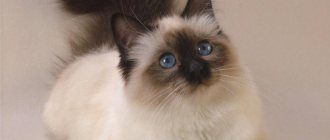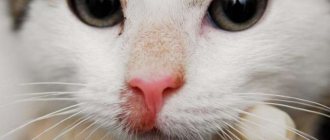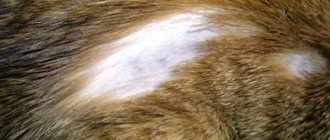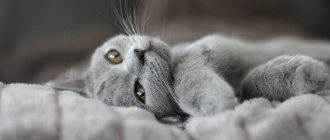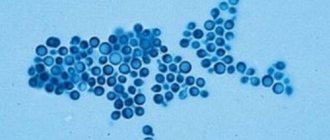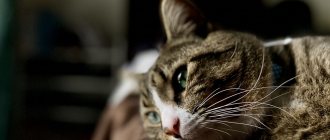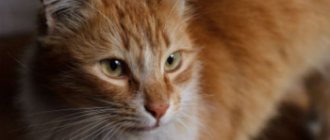Jaundice is a dangerous condition of the body, characterized primarily by yellowing of the mucous membranes of the mouth, lower eyelid, sclera, and inner surface of the ear. Lemon-yellow skin in a pet should greatly alert a responsible owner, as this symptom indicates the presence of serious health problems. What is this condition and how to deal with it?
Jaundice in cats is not an independent disease; it is a clear symptom of many pathological conditions.
Jaundice is caused by high levels of bilirubin. This useful substance, the so-called bile pigment, is part of hemoglobin, which is contained in erythrocytes - red blood cells that supply tissues and organs with oxygen. They are utilized in the liver, which produces the components it needs from their breakdown products. If the liver cannot cope with this task, bilirubin turns the cat's skin a characteristic color. Naturally, this is an abnormal condition of the body, requiring immediate contact with a veterinary service.
Jaundice in a cat is accompanied by the following symptoms::
- the color of urine and feces changes (urine becomes orange, feces become whitish)
- fever
- severe chills
- weakness
- poor appetite
- bloating
- diarrhea
- vomit
- extreme thirst
- excessive urination
- changes in behavior (aggressiveness or apathy)
Types of jaundice in cats
- Mechanical - occurs as a result of blockage of the liver ducts, gall bladder or excretory ducts by a foreign body, parasites or tumors. Due to a violation of the outflow, bile does not enter the intestines, being absorbed directly into the blood.
- Parenchymal - occurs when the functioning of liver cells is disrupted, because of this, its work is disrupted and bilirubin is released into the blood.
- Hemolytic - occurs with excessive destruction of red blood cells, which causes increased formation of bilirubin outside the liver.
What is bilirubin?
This is a bile pigment, which is formed after the breakdown of proteins, and contains the iron-containing fraction of heme - cytochrome cells, myoglobin and hemoglobin. As a result of breakdown, it is normally utilized through the liver, from there it enters the intestines along with bile and is excreted along with feces. Filtration also occurs in the kidneys.
There are two types of bilirubin - direct and indirect. Indirect is formed precisely at the moment of breakdown of red blood cells and is toxic to the body. Direct is formed after neutralization of unbound in the liver. It is slightly toxic and has the property of soluble in water.
Therapeutic measures
Treatment mainly depends on the underlying cause and is very individual. If the primary disease is very advanced, or the cat’s condition is close to critical, he may have to be hospitalized. In milder cases, a gentle diet is prescribed, the components of which do not put additional stress on the liver. Vitamins and preparations containing iron are often used (since the liver needs to be treated). If the cause of the pathology is a tumor or cyst that compresses the bile ducts, it is unlikely that it will be possible to do without a complex surgical operation. In Western veterinary clinics, blood transfusions are also constantly practiced for jaundice, but in our conditions this happens much less often, since there are no centralized blood banks for animals.
Causes
In most cases, the cause of jaundice in cats is liver damage. There are many factors that are accompanied by icterus (yellowness) of the skin and mucous membranes. Causes of parenchymal jaundice:
- Idiopathic familial hepatitis.
- Viral hepatitis.
- Cirrhosis and necrosis of the liver.
- Systemic diseases – leptospirosis, hypothyroidism, feline viral immunodeficiency.
- Sepsis.
- Lymphoma.
- Toxic liver damage - most common - from medications (paracetamol)
Factors that cause hemolytic jaundice include:
- Systemic diseases – lupus erythematosus.
- Viral infections – babesiosis, dirofilariasis, cytozoonosis, feline leukemia virus.
- Extensive hematomas.
The occurrence of obstructive jaundice is characterized by the following diseases:
- Pancreatitis.
- Formation of stones in the gall bladder.
- Parasites – opisthorchiasis, liver flukes.
- Cholangitis and bile duct defects.
- Damage to the integrity of the gallbladder.
There are also risk factors that can very often lead to the above diseases, and, consequently, jaundice.
The main risk factor in cats is obesity. It can lead to disruption of the functioning of the pancreatic gland and fatty liver changes. Jaundice also begins with sudden weight loss in obese cats, due to liver lipidosis.
Jaundice can be caused by hemolytic anemia, injudicious use of medications and trauma.
Factors that provoke jaundice
Improper maintenance and feeding of animals leads to obesity, and this, in turn, provokes pancreatitis in dogs or fatty hepatosis in cats. Some dog breeds are predisposed to jaundice, for example: cocker spaniels due to copper intoxication, Doberman pinschers (females) due to chronic active hepatitis.
Important! Incorrect administration of drugs can provoke the breakdown of red blood cells or other pathologies that are manifested by yellowness of the mucous membranes and skin. Therefore, veterinary specialists of the RosVet VC do not recommend that animal owners give medications “at random” without the participation of specialists.
Symptoms
Almost all types of jaundice are associated with a persistent increase in bilirubin in the blood serum and its deposition in tissues. Clinical signs of jaundice are associated with this feature of the development of the disease process.
The skin is yellow in color - from pale straw to saffron. The mucous membranes and sclera of the eyes are also stained. In cats, this symptom is most noticeable on the auricle and oral mucosa; the whites of the eyes can remain normal color for a long time.
Due to the high toxicity of indirect bilirubin, an increase in its concentration in the blood leads to severe disorders of the nervous system - changes in consciousness and degenerative disorders of the brain.
Depending on the causes and type of jaundice, the following symptoms may appear:
- Prehepatic (hemolytic jaundice) – the disease begins abruptly, enlargement of the liver and spleen occurs, anorexia, lethargy. Lymph nodes become enlarged and fever is possible. A change in stool is characteristic - the stool becomes orange.
- Subhepatic (mechanical) – it is characterized by discoloration of feces and dark urine (the color of dark beer). The abdomen enlarges, there is severe pain, weight loss and loss of appetite. Vomiting and diarrhea begin.
- Hepatic (parenchymal) - enlarged liver, dark brown urine and light-colored feces. General health changes, weight loss, polyuria and increased thirst. Ascites or abdominal effusion may occur. Due to brain damage, behavior changes - aggression, disorientation, ptyalism (increased salivation).
Prognosis and care for a sick animal
The prognosis for this disease mainly depends on the underlying cause and the proposed treatment. However, a proper diet, timely administration of medications, rest and supervision by a veterinarian will help your cat quickly restore its compromised health. Do not give medications or change their dosage without your veterinarian's approval. This especially applies to analgesics, which under normal conditions can be toxic to the liver, and in this case can even lead to the death of the animal. By the way, how to treat jaundice? Only a veterinarian should think about this, as your intervention could end very sadly!
Cats with liver failure need careful care from their owners, as their condition is extremely serious. At any time of the day or night, emergency veterinary attention may be required. If you see any signs of worsening, call a specialist immediately. This is especially true in cases where your pet's urine or feces have suddenly changed color. This indicates a sharp deterioration in the cat's condition. For example, the gallbladder could rupture: if you don’t immediately take the animal to the clinic, everything will end very badly!
It should be noted that in most cases, complete recovery cannot be achieved. The consequences remain forever. Therefore, the diet of a cat after jaundice is extremely important. How is it characterized? A small amount of fat, balanced in all essential minerals and vitamins... Simply put, inexperienced breeders would be better off purchasing special food for cats with kidney failure. If you do not have this opportunity, be sure to consult with a veterinarian who can create a professional, balanced diet for your sick pet.
Diagnostics
One of the first diagnostic methods is to take a blood test, which determines the presence of inflammation, anemia and altered red blood cells. It is also necessary to take a biochemical analysis to determine liver enzymes (ALT, AST and alkaline phosphatase). The level of direct and total bilirubin is also assessed.
Normal indicators in cats: ALT – from 19 to 78 units/l, AST – from 9 to 30 units/l, Bilirubin – from 2 to 16 µmol/l
A urine test also evaluates the presence of bilirubin and urobilinogen.
Blood smears are performed to determine parasites, as well as serological tests for feline immunodeficiency viruses, leukemia and leptospirosis.
If effusion or ascites is present, fluid analysis is performed.
To examine the liver, ultrasound is used, as well as radiography - it determines the presence of fluid, enlargement of the liver or spleen, as well as metastases or tumors.
Sometimes it is necessary to perform a liver biopsy and bile collection for bacteriological and cytological analysis.
For prehepatic jaundice, a blood clotting test (prothrombin index), an immune-mediated hemolytic anemia test, and a water-salt test (to determine the agglutination (clumping) of red blood cells) are performed.
How to clean a cat's yellow fur
There are times when you must take charge of caring for your cat. Here are the steps on how to bathe a cat:
- Preparing a bath : Place a bath towel in the bottom of the sink or bathtub. Fill the container about 6 cm with warm water.
- Place the cat in the water : Hold the cat under its belly with one hand. With your other hand, grab the cat's front paws and lower her down.
- Wet cat fur : Use a hand spray to rinse your cat's fur.
- Shampoo : Use one part of cat shampoo and massage it into your cat's coat.
- Draining : Remove water from the fur with stroking movements.
- Drying : Pat the cat dry with a towel and blow dry on low heat.
Treatment
All types of jaundice are treated based on the causes of the disease. Before treatment, a complete examination of the cat is required.
Diet
For the hepatic and subhepatic forms, a diet is prescribed using feed with a high content of easily digestible proteins. It is better to use ready-made food that is designed specifically for animals with liver disease. It is worth completely limiting salt, and also adding vitamins to the diet - C, group B, PP. Vitamin K1 is especially important; it is used for blockage of the bile ducts and cholestasis.
Drug therapy
It is important to strictly follow your doctor's recommendations. At the onset of the disease, the animal must be kept in a hospital until the condition stabilizes.
The drugs are used to treat the underlying cause of the disease. For hemolytic jaundice, a transfusion of blood or its components is often prescribed.
All drug treatment includes three main points:
- Etiotropic therapy – drugs that fight the cause of the disease. This could be antibiotics, antitoxic treatment, etc.
- Pathogenetic - which removes damaging factors of the disease, for example, destroyed liver cells, abdominal fluid or anemia.
- Symptomatic – treatment to alleviate the animal’s condition. It includes pain relief, antiemetics, etc.
Mechanical and parenchymal forms of therapy may require surgical treatment. It is possible to remove part of the liver, gall bladder or stones.
What drugs should you avoid:
- Tetracycline antibiotics – they have the property of reducing protein synthesis in the liver and can worsen the cat’s condition.
- If liver failure develops, analgesics and painkillers are excluded from treatment.
- Hepatotoxic drugs - paracetamol, erythromycin, etc.
Do not use medications without a doctor's prescription; most medications are processed in the liver. Therefore, the wrong medication or dosage can lead to liver failure, coma and even death of the pet.
Prevention measures and prognosis
To prevent diseases in cats and the development of severe pathological changes, veterinarians emphasize the importance of monitoring the animal’s condition and providing appropriate conditions of care and maintenance. Basic recommendations include compliance with the following rules:
- Feed regularly with high-quality balanced food on the recommendation of a veterinarian in accordance with the age and individual characteristics of the animal’s body.
- Do not leave leftover food, chemicals, or medications within the cat’s reach.
- Keep bowls and area clean.
- Provide constant access to clean water.
- In due time, do deworming and vaccination, remove fleas, remove plaque from the ears.
- Carry out regular preventive examinations of your pet by a veterinarian.
- Protect your cat from contact with stray animals.
- Treat emerging diseases in a timely manner.
The outcome of the disease depends on how quickly the owner brings the animal to the veterinarian.
The main factors influencing the prognosis of the disease:
- cause of pathology;
- timeliness of seeking medical help;
- age of the animal;
- thoroughness in following medical recommendations.
The yellow coloration of the cat and the disease passes slowly, the consequences can appear with successful treatment and the absolute normal condition of the animal. To maintain the liver and the health of the body, maintenance course therapy, therapeutic nutrition and regular monitoring of the cat’s well-being are prescribed.
Illustrations
Yellow sclera in cats
Yellow mucous membranes of the oral cavity
Icteric skin
Predisposing factors to the disease
Jaundice is caused by high levels of bilirubin in the blood. This bile pigment is formed in the cat's body as a result of the processing of hemoglobin from red blood cells. Hemoglobin is the most important component of blood, which saturates all organs and cells with oxygen. If hemoglobin is processed too quickly, the produced bilirubin does not have time to be utilized through the liver and gradually accumulates in the body, causing intoxication.
Jaundice often occurs due to liver disease.
Often, jaundice can occur due to concomitant liver diseases (cancer, cirrhosis, hepatitis), tumors compressing the bile ducts, or due to taking certain medications. It can be triggered by rupture of the gallbladder, blood diseases, bacterial infections, obesity, the presence of worms in the body, and poor quality nutrition. Jaundice can be caused by various bacterial and viral infections, blood transfusions, hepatic lipidosis, and impaired bilirubin production.
How to make a diagnosis
If your cat detects at least some signs of the disease, you should immediately seek advice from a veterinarian. Usually he prescribes general and biochemical blood tests. They will help to clarify the clinical picture of the disease, to notice changes in the circulatory system, the presence of parasitic infections and anemia in time. Biochemistry makes it possible to detect pathologies related to the synthesis of liver enzymes and blood clotting disorders. Sometimes a liver tissue biopsy may be required.
In addition, an ultrasound or x-ray examination may be required to determine liver pathology. This diagnostic method will allow you to reliably see a tumor or enlargement of the spleen, structural changes in the liver, and distinguish a malignant neoplasm from a parasitic cyst.
Clinical signs of the disease
The clinical picture of the disease is often accompanied by anemia, signs of which may include drowsiness, slight weakness, loss of appetite and constant or periodic fever. The nature of such anemia greatly influences the general clinical signs. But in general, cats tolerate low hematocrit much more easily than dogs.
The most dangerous is hemolytic jaundice, which is characterized by the following symptoms:
- liver enlargement;
- refusal to eat;
- sudden increase in temperature, fever;
- enlarged lymph nodes and spleen;
- orange cal.
The disease progresses very quickly and it is almost impossible to notice its signs in time. It is difficult to cure this type of jaundice, and the animal often dies.
Obstructive jaundice is characterized by:
- severe diarrhea;
- nausea and vomiting;
- abdominal enlargement;
- sudden weight loss;
- anorexia;
- darkening of urine.
Most symptoms will depend on what caused the jaundice. But the common symptoms are always yellowing and dryness of the skin and mucous membranes, constipation, nausea and vomiting, and abdominal pain. With jaundice, urine becomes bright orange, and stool becomes completely white.
Yellow staining of mucous membranes is a very dangerous symptom.
There is frequent urination and severe thirst, sudden weight loss, mental disorders and internal bleeding. In advanced cases, jaundice can result in coma and death. Therefore, it is very important to start treatment in a timely manner. Once a cat's eyeballs, gums, and inside of its ears turn yellow, it dies within a few days.
Why is this happening?
Many may have a question: nature clearly did not prepare cats for the need to brush their teeth like humans, but their wild relatives somehow cope. Is special hygiene really necessary? Are yellow teeth really dangerous for a cat?
The fact is that domestic purrs and wild cats live in completely different conditions. In their natural habitat, animals actually develop plaque much less frequently. This is because wild animals usually have to chew solid food, and they also find and chew various herbs. This in itself cleanses the tooth enamel. But even they have yellow plaque and tartar - not at all uncommon.
Domestic cats eat whatever their owner gives them. Often this food is softer than what their wild relatives get, therefore, natural teeth cleaning does not occur. Therefore, cat oral hygiene becomes a human task. Moreover, a good owner will not allow his pet to experience pain and discomfort.
Unfortunately, some owners neglect this responsibility and, over time, ask themselves questions: the cat has yellow teeth - what to do about it?


